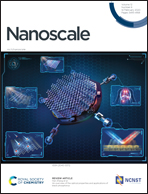Structural identification of percolation of nanoparticles
Abstract
We propose a method relying on structural measurements by small-angle scattering to quantitatively follow aggregation of nanoparticles (NPs) in concentrated colloidal assemblies or suspensions up to percolation, regardless of complex structure factors arising due to interactions. As an experimental model system, the dispersion of silica NPs in a styrene–butadiene matrix has been analyzed by small-angle X-ray scattering and transmission electron microscopy (TEM), as a function of particle concentration. A reverse Monte Carlo analysis applied to the NP scattering compared favorably with TEM. By combining it with an aggregate recognition algorithm, series of representative real space structures and aggregation number distribution functions have been determined up to high concentrations, taking into account particle polydispersity. Our analysis demonstrates that the formation of large percolating aggregates on the scale of the simulation box (of linear dimension 1/qmin, here micron-sized) can be mapped onto the macroscopic percolation characterized by rheology. Our method is thus capable of determining aggregate structure in dense NP systems with strong – possibly unknown – interactions visible in scattering. It is hoped to be useful in many other colloidal systems, beyond the case of polymer nanocomposites exemplarily studied here.



 Please wait while we load your content...
Please wait while we load your content...